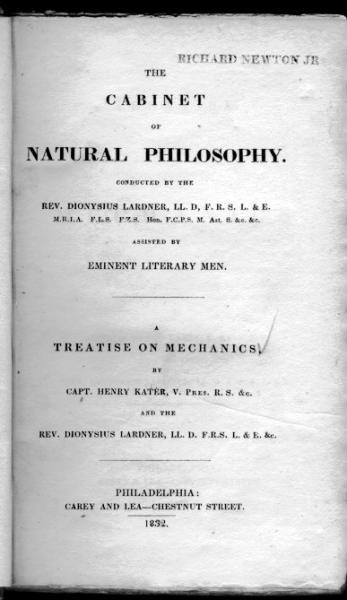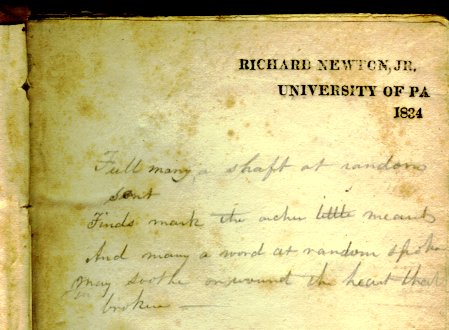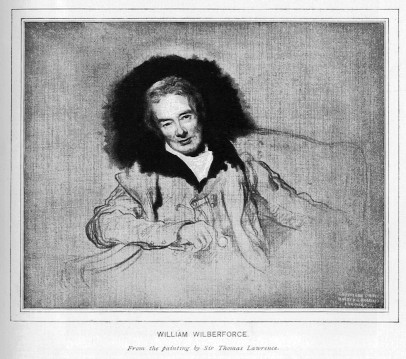Kater's Applied Mechanics
Today, a moving bit of marginalia. The University of Houston's College of Engineering presents this series about the machines that make our civilization run, and the people whose ingenuity created them.
I cut open the box, shake out the polystyrene popcorn, and remove a package from Seattle. There's a perfectly lovely old 1832 Treatise on Mechanics. It's one of Dionysius Lardner's Cabinet of Natural Philosophy books. Lardner co-opted all kinds of noted writers into working on his vast series of books -- first technical, then literary. Mary Shelley wrote anonymous stuff for Lardner after she wrote Frankenstein.
Now I turn pages, reading about matter and the forces that work upon matter. I read about pulleys, gears, engines, and screws. But I also discover a philosophy being spun around the new atomic theory of matter. What are we to make of these words:
Although we are unable by direct observation to prove the existence of atoms ... Yet ... many observable phenomena ... render their existence ... probable, if not morally certain.
I look for traces of the original owner. I want to know who entered this old portal into the moral certainty of the Victorian world.
The book was signed by Richard Newton at the University of Pennsylvania in 1834. History has not forgotten Richard Newton. He was born in England in 1812. His family moved to America when he was 12. He received some manual training, but then he went to college. He went on to become an Episcopal clergyman. But here we pick up echoes of a different Newton from the century before.
John Newton, born in 1725, went to sea at 11 and became captain of a slave ship when he was 23. He underwent a religious conversion after a terrible storm almost sank his ship. He repudiated the slave trade. It was he who wrote the text of the hymn Amazing Grace. John Newton became an Anglican clergyman and a formidable enemy of the slave trade.
Though Richard was no relation to John, he too became a potent opponent of slavery and a strong Union supporter during the Civil War. He wrote -- and wrote. His 18 volumes of published sermons for children were translated into a score of languages. He was a low-church evangelical, yet he helped to hold the church together when others like him tried to divide it. He was a reconciler.
For that reason, my breath catches when I spot a bit of marginalia in this old mechanics text. He's penciled a poem -- his own, I suppose -- under his name. In it he says:
Full many a shaft at random sent
Finds mark the archer little meant
And many a word at random spoken
May soothe or wound the heart that's broken.
Richard Newton really was a fitting spiritual heritor of John Newton. First he studied mechanics, underlining passages about the moral force of the new atomic science. Then he turned his attention to soothing that brave new world's wounds. I've just glimpsed the first halting steps -- that would define an entire life.
I'm John Lienhard, at the University of Houston, where we're interested in the way inventive minds work.
(Theme music)
Kater, H., and Lardner, D., A Treatise on Mechanics. Philadelphia: Carey & Lea, 1832.
See the Dictionary of American Biography for information on Richard Newton.
Richard Newton gave the name of William Wilberforce to one of his sons. William Wilberforce was the prime mover of the British antislavery movement.

Title page for Richard Newton's Treatise on Mechanics, 1832

Newton's stamped inscription and marginal poem

William Wilberforce
From the September 1896 Scribner's Magazine